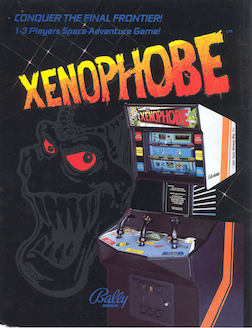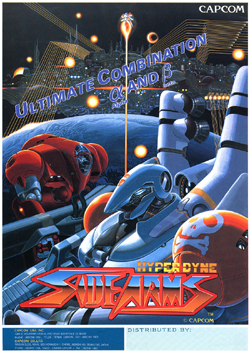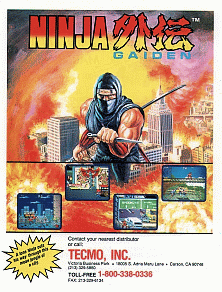
Xenophobe is a video game developed by Bally Midway and released in arcades in 1987. Starbases, moons, ships, and space cities are infested with aliens, and the players have to kill the aliens before each is completely overrun. The screen is split into three horizontally-scrolling windows, one for each of up to three players, yet all players are in the same game world.

Ms. Pac-Man is a 1982 maze arcade video game developed by General Computer Corporation and published by Midway. It is the first sequel to Pac-Man (1980) and the first entry in the series to not be made by Namco. Controlling the title character, Pac-Man's wife, the player is tasked with eating all of the pellets in an enclosed maze while avoiding four colored ghosts. Eating the larger "power pellets" lets the player eat the ghosts, who turn blue and flee.

Blockout is a puzzle video game published in 1989 by California Dreams. It was developed in Poland by Aleksander Ustaszewski and Mirosław Zabłocki. American Technos published an arcade version. Blockout is an unlicensed, 3D version of Tetris.

Klax is a puzzle video game released in arcades in 1990 by Atari Games while Namco distributed the game in Japanese markets. It was designed and animated by Mark Stephen Pierce with the software engineering done by Dave Akers. The object is to catch colored blocks tumbling down a machine and arrange them in colored rows and patterns to make them disappear. Klax was originally published as a coin-op follow-up to Tetris, about which Atari Games was in a legal dispute at the time.

APB is a video game released in arcades by Atari Games in 1987. The player assumes the role of "Officer Bob," a rookie police officer. As Bob, players drive around the city, ticketing motorists for minor infractions and pulling over more serious offenders. Eventually, players must apprehend criminals for which an all-points bulletin has been called.

Pac-Land is a 1984 side-scrolling arcade platform game developed and released by Namco. It was distributed in North America by Bally Midway, and in Europe by Atari Games. Controlling Pac-Man, the player must make it to the end of each stage to return a lost fairy back to its home in Fairyland. Pac-Man will need to avoid obstacles, such as falling logs and water-spewing fire hydrants, alongside his enemies, the Ghost Gang. Eating large flashing Power Pellets will cause the ghosts to turn blue, allowing Pac-Man to eat them for points.

Paperboy is an arcade action game developed and published by Atari Games and Midway Games, and released in 1985. The player takes the role of a paperboy who delivers a fictional newspaper called The Daily Sun along a suburban street on his bicycle. The arcade version of the game featured bike handlebars as the controller.

Phoenix is a fixed shooter arcade video game released in December 1980 by Taito. It was then released in Europe, and then in the Americas by Centuri and Amstar Electronics in January 1981.

Hyper Dyne Side Arms (サイドアーム) is a horizontally scrolling shooter developed and released by Capcom as an arcade video game in 1986. The player takes control of a flying mecha fighter who must battle an alien army. Side Arms uses a two-directional attacking system similar to Capcom's previous shoot-'em-up Section Z.

Rampage is a 1986 arcade game by Bally Midway. Players take control of a trio of gigantic monsters trying to survive against onslaughts of military forces. Each round is completed when a particular city is completely reduced to rubble. Warner Bros. currently owns all rights to the property via their purchase of Midway Games. Inspired by monster films, Rampage spawned five sequels and a film adaptation in 2018.

Rygar is a side-scrolling platform game created by Tecmo in 1986 and originally released for arcades in Japan as Argos no Senshi. The player assumes the role of a "Legendary Warrior", battling through a hostile landscape. The main feature of gameplay is the use of a weapon called the "Diskarmor", a shield with a long chain attached to it.

Galaga '88 is a 1987 fixed shooter arcade video game by Namco. It is the third sequel to Galaxian. It features significantly improved graphics over the previous games in the series, including detailed backgrounds, larger enemies and greater ship details. The game runs on Namco System 1 hardware.

RoadBlasters is a combat racing video game released in arcades by Atari Games in 1987. In RoadBlasters, the player must navigate an armed sports car through 50 different rally races, getting to the finish line before running out of fuel.

Zarlor Mercenary is a vertically scrolling shooter for the Atari Lynx handheld console, developed by Epyx and published by Atari Corporation.

S.T.U.N. Runner is 3D racing/shooter game released in arcades by Atari Games in 1989. The player pilots a futuristic vehicle which can exceed 900 mph, through various tunnels and courses with changing environments, hazards and enemies. S.T.U.N. Runner uses polygonal graphics for the vehicles and track, and is based on an evolution of Atari's Hard Drivin' hardware. The custom cabinet was designed to resemble the craft that the player pilots in-game.

Xybots is a 1987 third-person shooter arcade game by Atari Games. In Xybots, up to two players control "Major Rock Hardy" and "Captain Ace Gunn", who must travel through a 3D maze and fight against a series of robots known as the Xybots whose mission is to destroy all mankind. The game features a split screen display showing the gameplay on the bottom half of the screen and information on player status and the current level on the top half. Designed by Ed Logg, it was originally conceived as a sequel to his previous title, Gauntlet. The game was well received, with reviewers lauding the game's various features, particularly the cooperative multiplayer aspect. Despite this, it was met with limited financial success, which has been attributed to its unique control scheme that involves rotating the joystick to turn the player character.

Ninja Gaiden, released in Japan as Ninja Ryūkenden and in Europe as Shadow Warriors, is a 1988 side-scrolling beat-'em-up game, originally released by Tecmo as a coin-operated arcade video game. It was first released in North America and Europe in late 1988, and then in Japan in February 1989. It was the first game released in the Ninja Gaiden franchise. The arcade game was a major commercial success in North America, becoming the highest-grossing arcade conversion kit of 1989 in the United States.

Checkered Flag is a racing video game released for the Atari Lynx in 1991. A remake was released for the Atari Jaguar in 1994. Destination Software also planned to release a Game Boy Advance version of the title around 2005, but it was cancelled before it was released.

Hydra is a 1990 arcade vehicular combat video game developed and published by Atari Games. In Hydra, the player pilots a hovercraft, trying to deliver top secret items while avoiding mines, other hovercraft, and logs. The player can collect money and fuel to continue. X-Y yoke control.

Ninja Gaiden is a 1990 adaptation of the 1988 arcade game for the Atari Lynx under license from Tecmo.





















